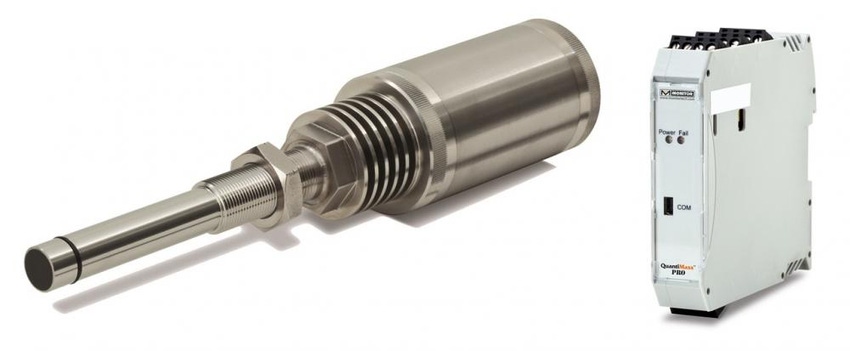In-line Flow Measurement Helps Quantify Material Inventory
October 24, 2017

An international manufacturer of PVC piping was looking for a method to validate the quantity of PVC powder received as it pneumatically conveys the raw material into a storage silo. It was particularly critical that the flow measurement be performed in-line (on-line) within the process, thereby achieving real-time data as the material is being received.
The company felt that an in-line, continuous solids flow measurement sensor would help them achieve their goals. The monitoring of the flow-rate for the PVC powder being received would assist them in two important ways:
1. Provide optimization of raw material inventory. The company wanted to connect the solids flow measurement sensor to their PLC to perform a totalizing function that provides a sum of the mass flow for a period of time.
2. Achieve real-time monitoring/visualization of actual material flow
The process consists of taking the raw material (PVC powder) from the receiving station to a storage silo using a pneumatic conveying line. The diameter of the conveying line (metal pipe) is approximately 6.5 in. and the conveying rate is typically around 70,000 lb/hr. The whole conveying and storage process takes 2-3 hours.
After some extensive research, the company decided to use the QuantiMass PRO in-line (also referred to as on-line) solids flow measurement system. Before the sensor was installed, the company and sensor manufacturer collaborated to determine the optimal location to place the sensor. The mass flow sensor was installed in a section of the pneumatic line before the material reached the storage silo. At this point, the company could obtain the flow-rate/volume of material being added into the silo. The sensor was installed in a location that was in a straight section as far away as possible from pipe transitions, bends, or elbows in the line. Using an optional DIN-rail transmitter, the company was able to have the output signal of the sensor integrate with their other control functions. The QuantiMass system has been successfully working and the company is pleased with the results. The accuracy being received in the process is approximately 1.5%.
In order to achieve maximum accuracy from this type of solids flow measurement sensor, several factors should be taken into consideration:
Vertical pneumatic or gravity conveying lines are usually best. Horizontal installations are possible, but there is the potential for compromised accuracy. Settled materials sliding down a chute are to be avoided.
A steel pipe or chute is needed. It is acceptable to sleeve the sensor location with steel.
Pneumatic conveying must be dilute phase conveying only, not dense phase conveying.
Particles must be airborne and the velocity of the conveyed material should be constant.
It is best if particle sizes are same size, or if size differences exist, the mixture of sizes should be consistent.
If the conveying line is to handle different material at different times, it is possible to set up the sensor, like the QuantiMass system, for separate calibration profile(s) for different materials. The QuantiMass can store up to 24 different calibration profiles. For remote switching between profiles an optional BCD switch is available.
Compact, in-line solids flow measurement sensors are commonly based off of microwave technology. The measurement process of the sensor is centered on the Doppler effect. The mass flow-rate is determined by evaluating the frequency and amplitude changes during the measurement process. Reproducible measurements can be made for most powders, dust, pellets, and granules, usually up to the size of 0.75 in.
Common reasons for using these types of sensors include obtaining in-line, continuous solids flow measurements for accurate validation of material quantities, measuring for proper mixing (blending) of additives in specific recipes and monitoring for variable flow quantities due to disturbances like different densities.
Some of the main criteria that the company was looking at when they chose the QuantiMass PRO system were:
Ability to easily incorporate the sensor into its process and receive continuous, real-time measurements without the use of weight scales
The proven microwave Doppler effect technology to provide accurate and reproducible flow measurements--typically around 1 to 3%
Compact size for easy installation into existing processes
Sturdy, non-intrusive sensor design that minimizes maintenance and wear and tear on instrument. This also means no obstruction to the material flow.
Fast measuring and adjustable sensitivity to produce quick, precise data for the specific material being processed at the time
The ability to do totalizing through a PLC. The sensor has an integrator/totalizer feature that can provide a sum of the mass flow for a period of time.
Application versatility: the sensor is suitable for powders, dust, pellets, and granular material up to 0.75 in. in pneumatic conveying and free-fall processes.
Summary
An in-line solids flow measurement sensor can be an easy way to incorporate a system that helps automate and verify the quantity of material being conveyed in a process. It can usually be added without requiring major changes to existing processes.
Monitor Technologies LLC is a manufacturer and supplier of level, flow, and moisture measurement sensors for powders and bulk solids. For more information, call 1-630-365-9403, e-mail [email protected], or visit www.monitortech.com
For related articles, news, and equipment reviews, visit our Instrumentation & Control Equipment Zone
Click here for a List of Instrumentation & Control Equipment Manufacturers
You May Also Like


